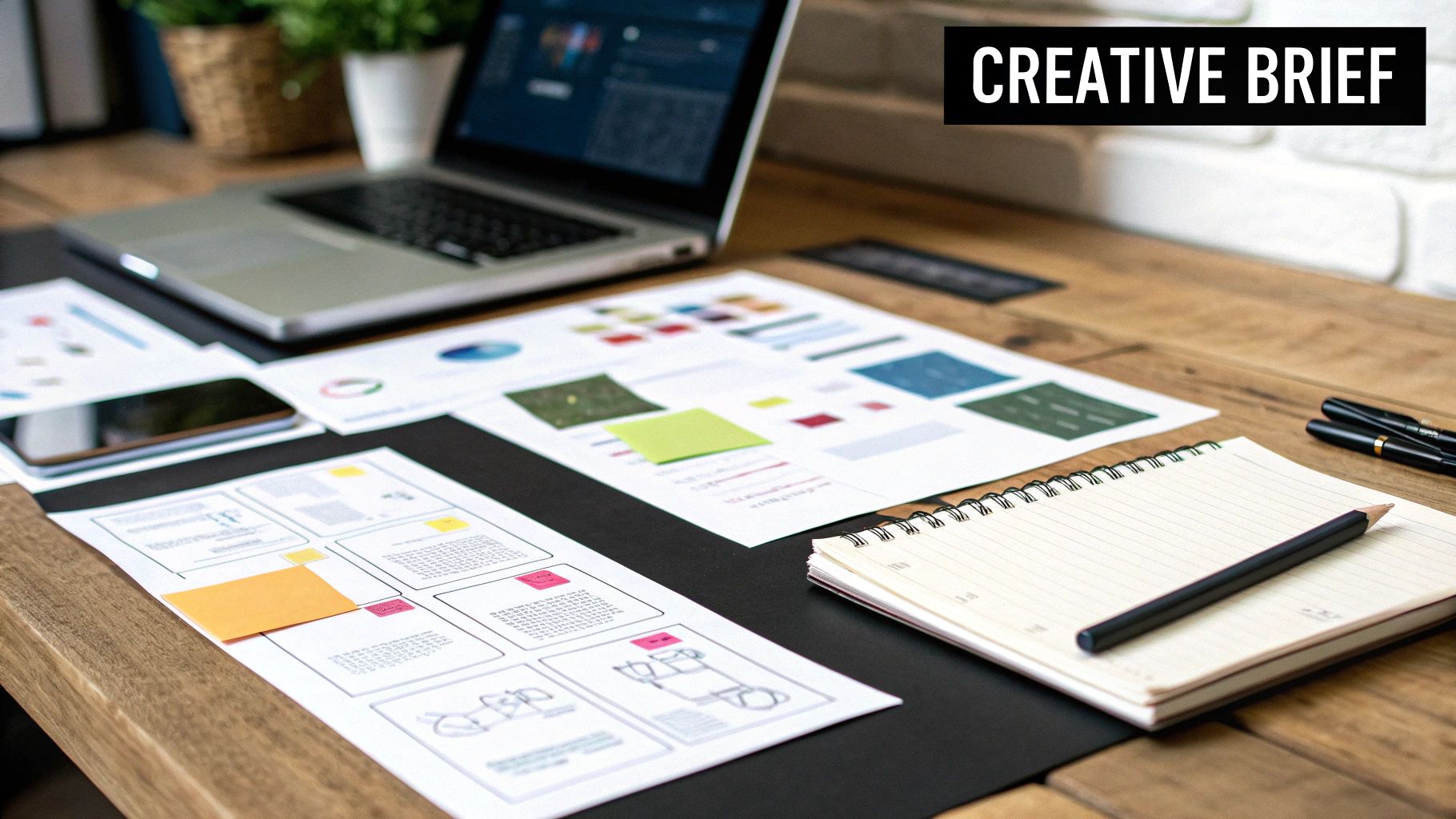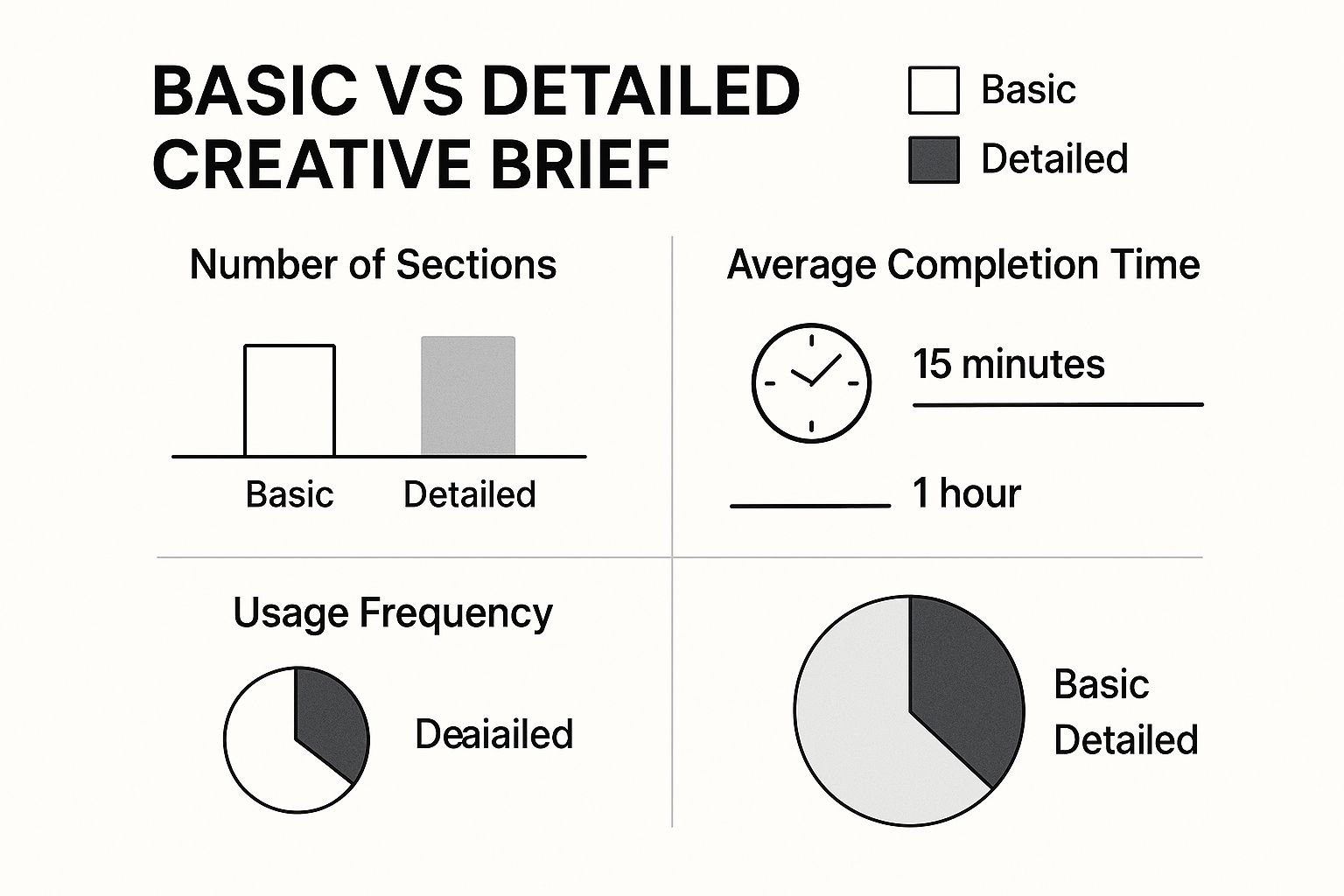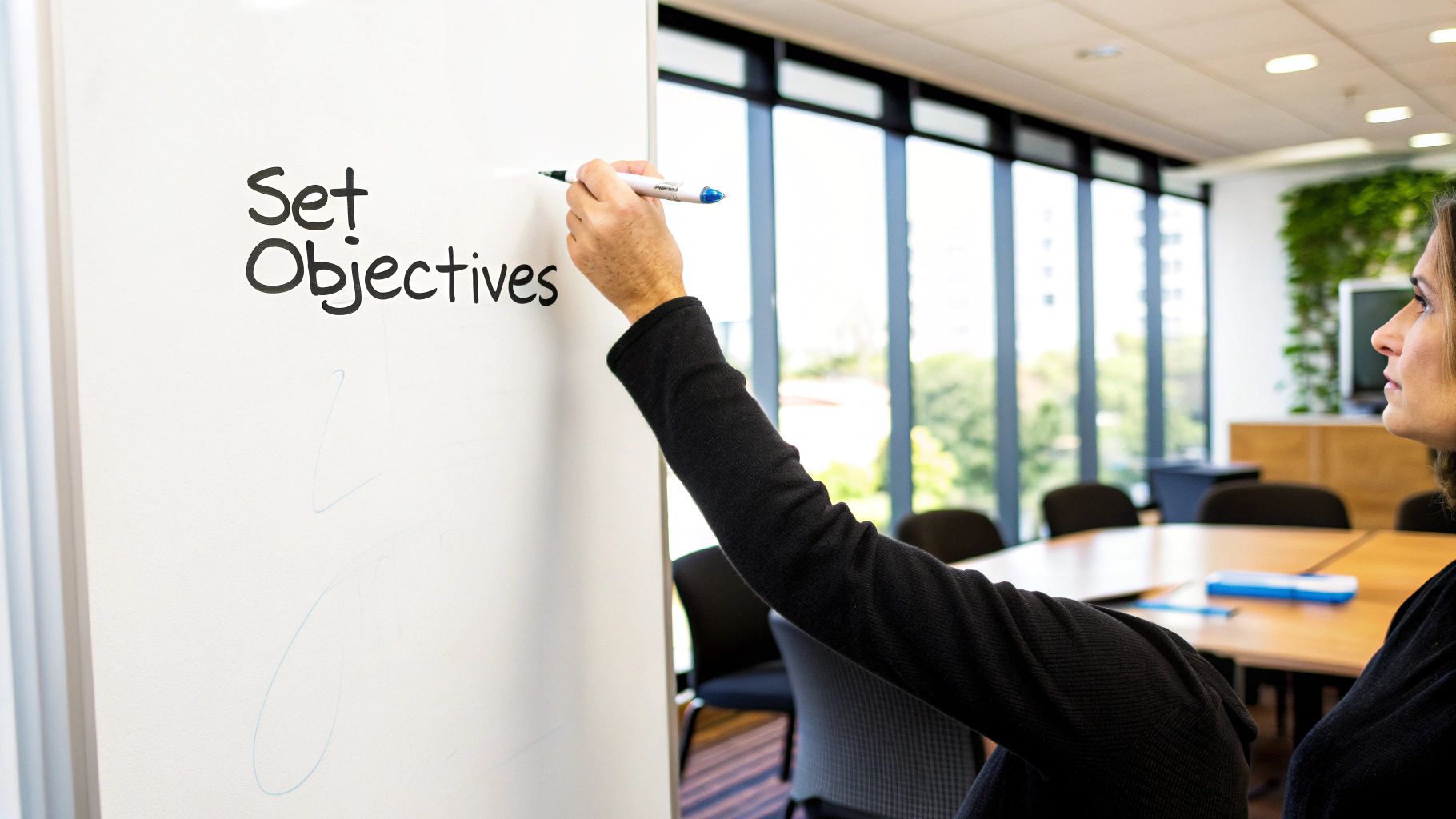The Strategic Power of an Effective Creative Brief

Great campaigns are the result of careful planning, not luck. A core element of this planning is the creative brief. This document acts as both a guide and a driving force for creative teams. It provides clarity and direction, ensuring everyone involved in the project is working towards a shared vision.
This seemingly simple document plays a critical role in successful marketing, ensuring alignment from initial concept to final execution. It helps prevent costly revisions mid-project and maximizes the impact of everyone's creative energy.
Why Creative Briefs Are Essential for Success
Effective creative briefs transform vague marketing goals into impactful campaigns. They serve as a central point of reference, guiding creative teams and aligning the final product with the client's vision. A well-crafted brief helps designers understand not only what they are creating, but also why.
For instance, a brief might outline the need for a new logo to establish a distinct brand identity in a competitive market. This deeper understanding empowers creatives to produce work that is both visually appealing and strategically effective.
A robust creative brief also promotes collaboration and keeps everyone on the same page. By clearly outlining project goals, target audience, and core messaging, it creates a shared understanding that minimizes miscommunication and keeps the project on track. This ultimately saves valuable time and resources.
Historically, the way creative briefs have developed highlights their increasing significance. Before the 1990s, informal discussions were often sufficient. As marketing became more sophisticated and data-driven, the need for structured briefs became apparent. By the early 2000s, nearly 80% of marketing campaigns utilized written briefs. Today, platforms like Bynder and FunctionFox simplify brief creation and management, further emphasizing their crucial role. Learn more about the history of creative briefs here: Marketing Brief vs. Creative Brief.
How a Creative Brief Prevents Project Drift
One major advantage of a well-defined creative brief is its ability to prevent project drift. This happens when a project veers off course due to miscommunication, shifting priorities, or a lack of clear direction. A comprehensive brief anchors the project, ensuring it stays focused on its core objectives.
This is especially crucial in complex projects involving multiple stakeholders and ever-changing requirements. A creative brief keeps all team members aligned, working towards shared goals. This not only reduces wasted effort but also results in a more cohesive end product. You might find additional resources helpful: Our Sitemap.
By minimizing the risk of wasted effort and ensuring a cohesive final product, a creative brief elevates the quality of creative work and strengthens the client-team relationship. This fosters trust and understanding, creating a foundation for lasting success and future collaborations.
Crafting a Brief That Both Guides and Inspires
A creative brief isn't just a document; it's the foundation of a successful campaign. It's the initial spark that transforms a simple idea into something truly captivating. This section explores how to elevate your creative briefs from basic instructions to inspiring blueprints for outstanding creative work.
Project Background: Setting the Stage
The project background provides essential context for the creative team. It explains the reasoning behind the project, outlining the challenge, opportunity, or problem the creative work aims to solve. It's the bedrock upon which the entire project is built. For example, if the project involves redesigning a website for a local bakery, the background might detail the bakery's difficulties with online orders and its goal to establish a stronger online presence. This context helps the creative team design a website that is both visually appealing and effective for the business.
Objectives: Defining the Destination
Clearly defined objectives offer direction without restricting creativity. They tell the team what needs to be achieved, not how to achieve it. This encourages creative exploration while keeping the project focused on its purpose. For instance, instead of "create a funny video," a stronger objective would be "increase brand awareness among young adults by 15% through a humorous video campaign." This sets a measurable target while allowing creative freedom. You might be interested in: How to master…
Value Proposition: Connecting With Your Audience
The value proposition explains the unique benefit a brand or product offers its target audience. It's the core message that resonates with consumers and encourages them to engage. A clear value proposition in the brief ensures the creative team understands the key selling points. For example, a value proposition for a new fitness app could be "achieve your fitness goals faster with personalized workout plans and expert guidance." This concisely communicates the app's benefits.
Balancing Structure and Creative Freedom
Effective creative briefs strike a balance: they provide structure and guidelines without stifling creative exploration. This requires a considered approach, setting boundaries while allowing room for innovation. Think of a jazz ensemble: the musicians have a structure (the melody and chord progression) yet they can improvise within that framework.
Before diving into the practical approaches, let's look at the key components of a well-crafted brief:
To illustrate this further, let's examine the essential elements of a comprehensive creative brief:
Essential Components of a Creative Brief
This table outlines the critical elements that should be included in every creative brief, explaining the purpose of each component and providing examples of effective implementation.
| Component | Purpose | Example |
|---|---|---|
| Project Background | Provides context and explains the "why" behind the project. | A local bakery wants to increase online orders due to low in-store traffic. |
| Objectives | Defines the goals of the project without restricting creative solutions. | Increase brand awareness by 15% among young adults. |
| Value Proposition | Articulates the unique benefit offered to the target audience. | Achieve fitness goals faster with personalized workout plans. |
| Target Audience | Specifies the demographics and psychographics of the intended audience. | Young adults (18-25) interested in fitness and healthy living. |
| Message | Defines the core message to be communicated. | Convenience and personalized support for achieving fitness goals. |
| Tone & Style | Sets the overall mood and aesthetic of the creative execution. | Energetic, motivational, and inspiring. |
| Deliverables | Specifies the expected outputs of the project (e.g., video, website, social media posts). | A series of short, engaging videos for social media. |
| Budget & Timeline | Outlines the financial and time constraints of the project. | $5,000 budget with a 4-week timeline. |
This table highlights the crucial role each component plays in shaping a successful creative brief. From establishing context to defining deliverables, each element contributes to a clear and actionable plan.
Practical Approaches for Finding the Sweet Spot
Finding the right balance requires clear communication and collaboration. Regular check-ins with the creative team and open discussions ensure everyone understands the project's direction. This fosters an environment where creative ideas can flourish while remaining aligned with the brief’s objectives. This collaborative process helps ensure the final product is both creative and strategically sound.
Bringing Your Target Audience to Life
Understanding your target audience is paramount to a successful creative brief. This means going beyond basic demographics and diving into the deeper motivations, frustrations, and aspirations that drive their actions. This section explores developing rich audience insights, empowering creative teams to produce truly resonant work.
From Data Points to Human Truths
Effective creative briefs transform raw data into compelling narratives. Instead of just listing age ranges and income brackets, they paint a vivid picture of the individuals you're trying to reach. This means understanding their values, challenges, and what truly matters to them. For example, imagine marketing organic baby food. Knowing your target audience is parents aged 25-35 is helpful. However, understanding their anxieties about providing healthy options for their children offers much more powerful creative direction.
This deeper understanding allows creative teams to connect with the audience emotionally. It enables them to craft messages resonating with their deepest needs and desires. This approach transforms marketing from a broadcast into a conversation, fostering genuine engagement.
Gathering Meaningful Audience Intelligence
There are several ways to gather the insights needed to create these multi-dimensional audience profiles. Social listening lets you tap into online conversations, uncovering what your target audience says about your brand and competitors. SproutSocial is a popular platform for this. Customer interviews provide invaluable first-hand perspectives, revealing the "why" behind consumer behavior. Behavioral analysis helps identify patterns in how consumers interact with your brand, offering clues about their motivations and preferences. Google Analytics can be a powerful tool for understanding user behavior on your website.
When writing a creative brief, understanding your target audience is crucial. A 2019 study by WARC, a global marketing intelligence firm, found that effective audience targeting can increase ad recall by up to 20% and brand awareness by 18% compared to less targeted methods. Creating a pen portrait of the consumer involves defining and segmenting your audience into accurate personas. This helps teams understand their needs, wants, and desires.

For instance, using data from platforms like GlobalWebIndex, you can develop audience profiles revealing how consumers interact with brands and what influences their buying decisions. This ensures your creative strategies align with consumer behaviors and preferences, leading to more impactful campaigns. Learn more about effective audience targeting here: How to Write a Creative Brief.
Crafting Compelling Audience Narratives
After gathering audience intelligence, the next step is transforming it into compelling narratives that inspire creative teams. This means moving beyond dry data and crafting stories that bring your target audience to life. These narratives should capture who your audience is, what they care about, and what motivates them.
For instance, instead of stating that your target audience is "eco-conscious," tell a story about a young professional who prioritizes sustainable living and seeks brands sharing their values. This helps creative teams understand the human truths behind the data, allowing them to develop more authentic and engaging campaigns. See our guide on How to master….
The Impact of Human-Centered Briefs
By focusing on the human element, you empower creative teams to create work that truly connects. This leads to more effective campaigns, stronger brand loyalty, and ultimately, better business results. This approach ensures your creative efforts aren't just seen but felt. It transforms marketing from a transactional process into a meaningful interaction, building lasting relationships between brands and consumers.
Defining Goals That Transform Ideas Into Results
What separates a truly successful campaign from one that misses the mark? It often comes down to the creative brief. This document guides the entire creative process. This section explores crafting objectives that drive real, measurable results, transforming big ideas into tangible achievements.
From Business Ambitions to Creative Direction
A crucial step in writing a creative brief is translating overall business goals into actionable creative direction. This requires a deep understanding of both the business' needs and the creative process itself. For example, a business might want to "increase market share by 10%." While important, this is too broad for a creative team.
A corresponding creative objective could be "create a social media campaign that generates 1,000 new leads in the next quarter." This provides a measurable target and gives creatives the flexibility to innovate. This targeted approach connects the creative work directly to the business strategy.
It provides a clear roadmap for the team, ensuring everyone is working towards the same goal. This alignment between business objectives and creative execution is essential for maximizing impact.
To illustrate this further, let's look at a comparison table:
This table shows how broad business goals can be translated into specific creative objectives.
| Business Objective | Creative Brief Objective | Measurement Criteria |
|---|---|---|
| Increase market share by 10% | Create a social media campaign that generates 1,000 new leads in the next quarter. | Number of leads generated through social media |
| Improve brand awareness | Increase positive social media sentiment by 20% within six months. | Social media sentiment analysis tools |
| Drive more traffic to the website | Develop a content marketing strategy that increases website traffic by 15% in the next year. | Website analytics |
This table emphasizes the need to clearly define what needs to be achieved and how it will be measured. This ensures that the creative team's efforts contribute to the overall business goals.
Developing SMART Objectives
Creative projects, just like any other business initiative, benefit from SMART objectives. This widely used framework means ensuring objectives are Specific, Measurable, Achievable, Relevant, and Time-bound. Instead of a vague objective like "improve brand perception," a SMART objective would be "increase positive social media sentiment by 20% within six months." This clarifies what needs to be done, how success will be measured, and the timeframe.
SMART objectives provide a framework for accountability and progress tracking. They keep the project focused and on track, minimizing scope creep and ensuring that the creative output aligns with the desired results. This structured approach leads to more efficient and effective campaigns.

As this infographic illustrates, while basic templates are faster, detailed briefs are used more often, highlighting the value of a comprehensive approach.
Defining Deliverables With Crystal Clarity
Clear deliverables are fundamental to a successful creative project. The creative brief should specify exactly what the team needs to produce. This might include website designs, social media graphics, video scripts, or other creative assets. Each deliverable needs clear requirements like dimensions and file formats.
This clarity prevents confusion and ensures the team delivers what's needed. It also promotes smoother collaboration between team members and stakeholders, as everyone understands the expected outputs. This streamlined approach sets the stage for project success.
Avoiding Common Pitfalls in Objective-Setting
Several common mistakes can hinder a creative brief's effectiveness. These include unrealistic goals, undefined metrics, and misalignment with the target audience. For instance, expecting a 100% increase in brand awareness quickly is likely unrealistic. Focusing solely on aesthetics without considering audience preferences can also lead to an ineffective campaign.
By understanding these pitfalls, you can craft a creative brief that sets the project up for success. This ensures the work is both visually appealing and strategically aligned with business goals. This focus maximizes the chances of achieving meaningful results. For further information on project management best practices, explore resources like those available on Creative Project Management.
Harnessing Data to Fuel Creative Breakthroughs

The best creative briefs are built on a foundation of solid data, not just gut feelings. This data-driven approach helps marketers turn raw numbers into actionable insights. These insights, in turn, fuel unique and successful campaigns. Let's explore how to pinpoint key metrics and present data in a way that sparks true creativity.
Identifying Key Metrics For Your Project
Not all data is equally valuable. The first step is figuring out which metrics truly matter for your specific project. For a brand awareness campaign, social media engagement and reach might be most important.
But for a lead generation campaign, conversion rates and cost-per-lead become the focus. Choosing the right metrics lets you concentrate your energy and measure what truly drives success. This focused approach keeps your creative efforts aligned with your business goals.
Presenting Data to Inspire Creativity
Presenting data effectively is crucial. Simply handing a creative team a spreadsheet can be overwhelming and stifle inspiration. Instead, translate complex data points into clear creative direction.
- Visualizations: Charts and graphs can make data easier to digest and understand.
- Narratives: Craft stories around the data. For example, if data shows a specific demographic engages with certain content, build a persona around that group and their preferences. This helps creatives connect with the audience on a deeper level.
This human-centered approach makes data relatable. Statistically, data-driven creative briefs positively impact campaign success. In some cases, they've led to a 25% increase in campaign engagement. For more detailed statistics, check out: Creative Briefs With Data.
Case Studies: Data in Action
Real-world examples show the power of data-driven creative briefs. One agency used customer behavior data to find a previously untapped market segment. This discovery led to a highly successful campaign that significantly boosted sales.
Another agency used competitive analysis data to identify a key differentiator for their client. The resulting campaign effectively positioned the brand in a crowded market. These stories highlight the potential of data to reveal hidden opportunities and drive innovative creative solutions. For further information on how Creativize can help bridge the gap between businesses and creative professionals, check out our guide on Creative professionals.
Balancing Analytical Thinking With Creative Exploration
While data is essential, it's important to balance analytical thinking with creative freedom. The creative brief should provide direction, not restrictions. Think of data as the foundation for creative growth.
It offers the framework and insights, but it's the creative team's role to bring those insights to life in innovative and engaging ways. This balance ensures data informs the creative process without stifling imagination. It lets data serve as a springboard for creative ideas, leading to campaigns that are both strategically sound and visually compelling. This combined approach creates work that truly stands out.
Capturing Your Brand's Authentic Voice
Your brand's voice isn't just about what you say, but how you say it. It's the personality that comes through in every interaction, shaping your audience's perception. This section explores how to capture this unique personality in your creative brief, so creative teams can consistently represent your brand's authentic voice.
Defining Tone, Voice, and Visual Language
A brand's voice has several key elements: tone, voice, and visual language. Tone is the emotional inflection of your message. Is it playful, serious, or informative? Voice is the overall personality expressed through language. Are you friendly, authoritative, or quirky? Visual language encompasses the visual elements that communicate your brand identity, including your logo, color palette, and imagery.
For example, Dove's visual language often features real women, promoting body positivity. Their tone is empowering and supportive. This combination creates a cohesive and recognizable brand identity.
These elements work together to create a consistent brand experience. Imagine a brand with a playful tone on social media, but a formal voice on its website. This inconsistency confuses the audience and weakens the brand's message. Defining these elements clearly in the creative brief ensures all creative output aligns with the overall brand identity.
Communicating Brand Attributes and Positioning
Your creative brief should clearly communicate your brand's core attributes and competitive positioning. These factors inform creative decisions without dictating specific solutions. Identify what makes your brand unique. How does it stand out in the marketplace?
Is it known for innovation, affordability, or customer service? Clearly articulating these aspects in the brief guides the creative team toward solutions that reinforce your brand’s strengths. For example, a brand known for innovative products should encourage creative solutions that highlight this attribute, perhaps through futuristic designs and impactful visuals.
Balancing Brand Guidelines and Creative Opportunity
A successful creative brief balances brand guidelines with creative opportunity. Brand standards are essential for maintaining consistency, but they shouldn't stifle creativity. The brief should outline the non-negotiables while providing flexibility for the creative team to explore and innovate.
Think of it like providing a canvas with some initial sketches. The artist understands the general direction but has the freedom to add their own artistic interpretation. This balance leads to creative solutions that are both on-brand and fresh. Learn more in our article about sitemap.
Inspiring, Not Restricting, the Creative Process
Explain brand standards in a way that inspires, rather than restricts. Instead of a list of rules, share the story behind your brand identity. Explain the why behind the guidelines.
For example, instead of stating, "Our logo must always be blue," explain that blue represents trust and stability, core values of the brand. This approach empowers the creative team to understand the brand's essence. They can then apply the guidelines thoughtfully, leading to more authentic and impactful creative work. This collaborative approach fosters a deeper understanding of the brand and encourages suitable creative solutions.
From Theory to Practice: Templates That Actually Work
Now, let's turn theory into action. This section offers practical templates and proven processes to create effective creative briefs that inspire great work. This is where the planning gets real, transforming ideas into concrete steps.
Customizable Templates For Various Projects
Just as there's no universal marketing strategy, there's no single perfect creative brief template. Different projects require different approaches. A brief for a social media campaign will look quite different from one for a website redesign.
That's why using customizable templates tailored to specific project types is so important. Whether you're building an integrated marketing campaign, crafting a digital experience, or leading a content initiative, a relevant template provides a solid foundation. These templates offer a structured framework, ensuring you address all the key elements.
Here are a few project types and how their templates might differ:
- Integrated Campaign: Focus on coordinating messaging across various channels and aligning different marketing efforts.
- Digital Experience: Emphasis on user experience, interface design, and user journey mapping.
- Content Initiatives: Concentration on core content, target keywords, and audience engagement.
Having a project-specific template streamlines the briefing process and ensures the creative team has all the necessary details.
Strategic Annotations For Adaptation
A good template is more than just a form. It should include strategic annotations that explain how to adapt it to your specific needs and limitations. These annotations guide what information to include in each section and how to tailor it to the project.
For example, a section on target audience might include notes explaining the value of psychographic details beyond demographics. This guidance ensures a comprehensive brief packed with valuable insights for the creative team. This support helps tailor the template effectively, resulting in a more impactful brief.
Effective Briefing Processes: Collaboration and Feedback
Leading agencies use briefing processes that go beyond handing over a document. Collaborative workshops gather key stakeholders and the creative team to brainstorm and build a shared project understanding. Stakeholder alignment techniques help ensure everyone is on the same page, working towards common goals. Methods for soliciting productive feedback create clear communication channels and refine the creative direction.
These collaborative methods promote open communication and ensure everyone’s voice is heard. This shared understanding and combined input lead to a stronger, more effective brief and a more successful project.
Overcoming Common Challenges
Even with the best templates and processes, challenges happen. Working with limited information means making educated assumptions and prioritizing research. Juggling multiple stakeholder priorities requires finding common ground and balancing competing needs. Maintaining brief integrity through project changes means regularly reviewing and updating the brief to reflect any shifts in scope or direction.
These proactive measures keep the project moving forward. Addressing challenges head-on ensures a smoother process, minimizes disruptions, and lets the creative team focus on delivering excellent results.
Brief Presentation: Igniting Excitement
The way you present the creative brief greatly impacts its effectiveness. Simply listing facts and figures won't inspire creative excellence. Instead, strive to build team excitement and generate enthusiasm. Use visuals, storytelling, and interactive elements to engage the creative team. Clearly explain the project's potential impact and the opportunity for creative innovation.
A compelling presentation sets the stage for great work. By inspiring the creative team, you foster an environment for innovative ideas. This enthusiasm translates into more creative and impactful solutions.
Ready to transform your creative projects and connect with top local talent? Visit Creativize today to see how our platform can help you achieve your creative goals.

